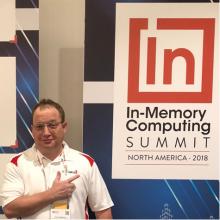 With some 30 breakout sessions, the In-Memory Computing Summit Europe 2019, happening June 3-4 in London, is a must-attend learning event for data scientists across the region.
With some 30 breakout sessions, the In-Memory Computing Summit Europe 2019, happening June 3-4 in London, is a must-attend learning event for data scientists across the region.
For today’s blog post I had the chance to speak with one of the many in-memory computing experts who will be speaking there: Chris Jenkins, senior director of In-Memory Technology at Oracle. His talk is titled, “Cloud Adjacent Databases Facilitate Migration to Cloud.”
Chris explained how “cloud-adjacent databases” are critical to application migration patterns to cloud. They provide access to a variety of microservices available in public clouds – as well as rich interconnections to SaaS services. For example, cloud-adjacent deployments are well-suited for organizations writing their own applications in cloud microservices that need to use existing on-premise application and SaaS workflows.
His session is scheduled for June 3 -- Day 1 of the two-day conference at the Park Plaza Victoria, London. Here’s what he had to say about his session.
Q: Chris, your talk will focus on the Oracle TimesTen In-Memory Database. In a nutshell, what is TimesTen and how is it being used in the context of your session (scheduled for June 4 at 11 a.m.)? That is to say, for a cloud adjacent database in the context of hybrid deployments?
A: That's right Tom. TimesTen is a powerful and mature relational in-memory database that offers low latency data access, high transactional throughput and high-availability with familiar APIs. TimesTen can be deployed in 3 different ways to meet a multitude of application requirements. In this session I will be looking at hybrid deployments (where the application is split between on-premise and the cloud) and how TimesTen can facilitate this type of deployment, in particular by improving performance and availability.
Q: What are some real-world examples of how this is being done today?
A: A good example of this is a very large automotive manufacturer that we are working with. They are building a “crowd-sourced” navigation and traffic alert platform for self-driving cars. This will collect real-time information from the vehicles sensors (GPS location, speed, direction etc.) and use this to provide traffic information, parking suggestions and optimized navigation for self-driving cars. By deploying a network of TimesTen databases which are co-located with network access points they can dramatically reduce the cellular data consumption, vehicle to database latency and offload some of the lighter weight analysis to the local machines leaving the main cloud database to focus on mass data storage and complex analytics. Availability is also improved as the system is more resilient to transient network outages. The end result is a much better experience for their customers.
Q: What are some of the key benefits of cloud-adjacent databases for applications?
A: It's really two main areas; lower latency and higher availability. By placing persistent, highly available data caches close to the non-cloud application components you can insulate them to a large degree from the inevitable high latency of remote access to data stored in the cloud. That isolation also helps shield the applications from the effects of transient network outages or glitches since they talk to the caches and not directly to the central cloud hosted database.
Q: Can you share some of the architectural elements of this migration pattern?
A: The main elements are:
- A central cloud hosted database of some sort which is the primary data repository for one or more applications. As far as TimesTen is concerned this would normally be an Oracle database of some sort, perhaps Exadata Cloud Service or maybe the ATP or ADW services for example, as this allows you to leverage the built-in caching functionality of TimesTen. Of course, if you are willing to build some of the 'plumbing' yourself then you could use any kind of backend database. (and TimesTen provides APIs that can make that very easy). We have plans to pre-integrate TimesTen with the ATP & ADW services to provide a seamless experience to customers who wish to use TimesTen in this configuration.
- Applications whose components are deployed either wholly on-premise or a mix of on-premise and cloud and where the applications are latency sensitive and need reliable data access most or all of the time.
- A small footprint, high capability, high performance in-memory database that can operate as a cache and which can be easily deployed on small to medium capacity servers in the field. In our vision this is where TimesTen fits perfectly.
- Access to direct connect network infrastructure that allows you to connect all these components (intra-cloud, inter-cloud, on-premise, Internet…)
***
Enter our raffle for a chance to purchase a full-access ticket to the In-Memory Computing Summit Europe 2019 for just £20! The conference is June 3-4 in London. Full (Early Bird) price is £450! Take a chance and save BIG! Share and follow the action at the summit with us on Twitter @IMCSummit
